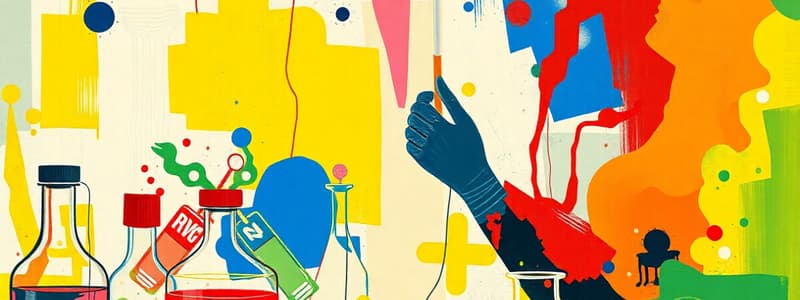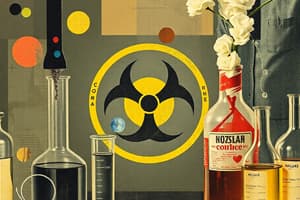Podcast
Questions and Answers
Which of the following is the primary purpose of laboratory safety procedures?
Which of the following is the primary purpose of laboratory safety procedures?
- To make the lab look more organized
- To increase the speed of experiments
- To minimize risk to workers and protect property (correct)
- To reduce the cost of materials
Why is it important to avoid rushing when conducting experiments in a laboratory?
Why is it important to avoid rushing when conducting experiments in a laboratory?
- To have more time to socialize with colleagues.
- To ensure the lab is clean for the next person.
- To prolong the experiment and gather more data.
- Rushing increases the likelihood of mistakes and potential harm. (correct)
During an experiment, a small amount of toxic gas is released due to a faulty setup. What immediate action should be taken?
During an experiment, a small amount of toxic gas is released due to a faulty setup. What immediate action should be taken?
- Ignore the leak if it's not immediately irritating.
- Quickly neutralize the gas with another chemical.
- Evacuate the area and report the leak to the supervisor. (correct)
- Open all windows and continue with the experiment.
Which of the following practices is essential for minimizing risks associated with chemical use in a lab?
Which of the following practices is essential for minimizing risks associated with chemical use in a lab?
Which of the following scenarios requires the immediate use of personal protective equipment (PPE)?
Which of the following scenarios requires the immediate use of personal protective equipment (PPE)?
Why is it important to make a plan of action before starting an experiment?
Why is it important to make a plan of action before starting an experiment?
What should you do if you accidentally spill a corrosive chemical on your skin?
What should you do if you accidentally spill a corrosive chemical on your skin?
Which of the following is a key reason not to work alone in a laboratory?
Which of the following is a key reason not to work alone in a laboratory?
You notice a frayed electrical cord on a piece of lab equipment. What should be your immediate response?
You notice a frayed electrical cord on a piece of lab equipment. What should be your immediate response?
What specific information should be prioritized when reading experiment instructions before starting?
What specific information should be prioritized when reading experiment instructions before starting?
You are unsure about the correct disposal method for a chemical waste product. What should you do?
You are unsure about the correct disposal method for a chemical waste product. What should you do?
What is the MOST important reason for using designated tubes for specific experiment steps?
What is the MOST important reason for using designated tubes for specific experiment steps?
Which scenario poses the HIGHEST risk in a chemical laboratory environment?
Which scenario poses the HIGHEST risk in a chemical laboratory environment?
How does maintaining a clean and uncluttered workspace contribute to laboratory safety?
How does maintaining a clean and uncluttered workspace contribute to laboratory safety?
In what situation is it acceptable to remove your safety goggles in the lab?
In what situation is it acceptable to remove your safety goggles in the lab?
During an experiment, you accidentally break a glass container. What is the FIRST step you should take?
During an experiment, you accidentally break a glass container. What is the FIRST step you should take?
Why is it UNSAFE to eat or drink in the laboratory?
Why is it UNSAFE to eat or drink in the laboratory?
How should you adjust your plans if you realize that an experiment is riskier than initially anticipated?
How should you adjust your plans if you realize that an experiment is riskier than initially anticipated?
Which statement accurately describes the definition of 'Safety in Laboratories'?
Which statement accurately describes the definition of 'Safety in Laboratories'?
How can you ensure that flames remain controlled and safe during an experiment involving flammable materials?
How can you ensure that flames remain controlled and safe during an experiment involving flammable materials?
Flashcards
Laboratory Safety Definition
Laboratory Safety Definition
A set of procedures and rules designed to protect laboratory workers from injury, property from damage, and provide safe working environments.
Main Lab Hazards
Main Lab Hazards
Fires, skin/eye exposure to chemicals, toxic gas leaks, glass fragments, electric shock, and hot objects.
General Lab Rules
General Lab Rules
Plan your work, don't rush, read the experiment, check chemical names, wear PPE, no food/drink, keep flames away, use correct tubes, avoid working alone.
Personal Protective Equipment (PPE)
Personal Protective Equipment (PPE)
Signup and view all the flashcards
Radioactive Symbol
Radioactive Symbol
Signup and view all the flashcards
Biohazard Symbol
Biohazard Symbol
Signup and view all the flashcards
Harmful Symbol
Harmful Symbol
Signup and view all the flashcards
Explosive Symbol
Explosive Symbol
Signup and view all the flashcards
Corrosive symbol
Corrosive symbol
Signup and view all the flashcards
Dangerous for the environment symbol
Dangerous for the environment symbol
Signup and view all the flashcards
Flammable symbol
Flammable symbol
Signup and view all the flashcards
Toxic Symbol
Toxic Symbol
Signup and view all the flashcards
Oxidizing symbol
Oxidizing symbol
Signup and view all the flashcards
Study Notes
- Safety in laboratories involves procedures and rules to protect workers from injury and property from damage, ensuring safe working conditions.
Main Hazards in Chemical Laboratories
- Fires can start from preparations or experiments.
- Skin and eyes can be burned or exposed to toxic chemicals.
- Toxic or irritating gases can leak.
- Exposure may occur to glass residues or fragments.
- Risk of contact with electric current.
- Risk of contact with hot objects.
General Rules for Risk Management in Laboratories
- Plan your lab work and define your objectives before starting.
- Avoid rushing, as it can lead to harmful mistakes.
- Carefully read the experiment instructions, paying attention to the risks.
- Check and read chemical names on bottles and containers.
- Wear PPE, including a lab coat, face mask, gloves, and protective glasses, before entering.
- Eating and drinking is prohibited in the lab.
- Keep flames away from your workspace.
- Use appropriate tubes for the experiment.
- Avoid working alone or outside of regular hours.
Studying That Suits You
Use AI to generate personalized quizzes and flashcards to suit your learning preferences.




